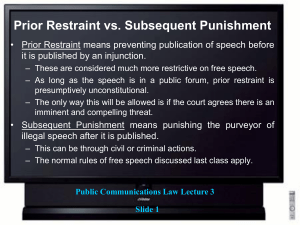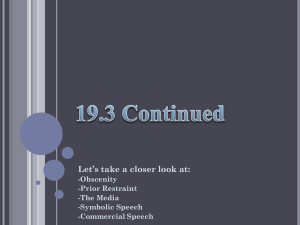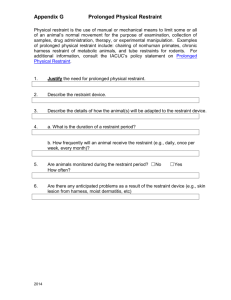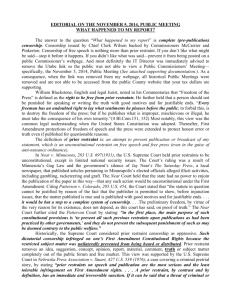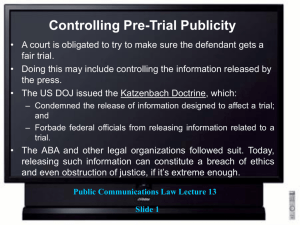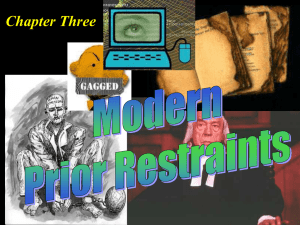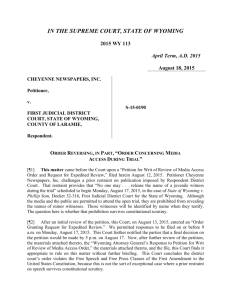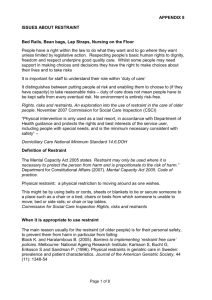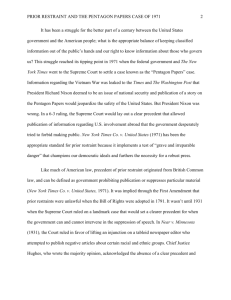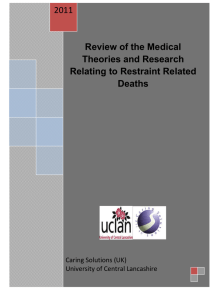Prior Restraint vs. Subsequent Punishment
advertisement
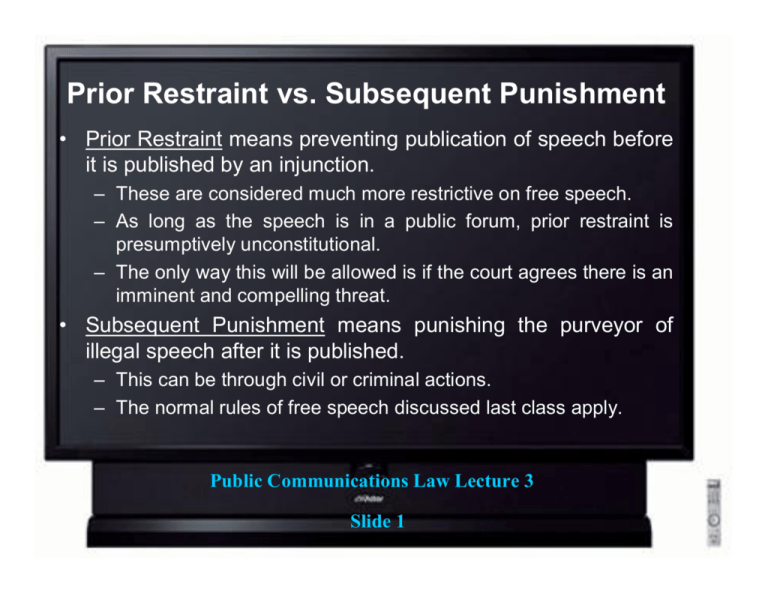
Prior Restraint vs. Subsequent Punishment • Prior Restraint means preventing publication of speech before it is published by an injunction. – These are considered much more restrictive on free speech. – As long as the speech is in a public forum, prior restraint is presumptively unconstitutional. – The only way this will be allowed is if the court agrees there is an imminent and compelling threat. • Subsequent Punishment means punishing the purveyor of illegal speech after it is published. – This can be through civil or criminal actions. – The normal rules of free speech discussed last class apply. Public Communications Law Lecture 3 Slide 1 When is Prior Restraint Allowed? • To stop speech not protected, like: – Obscenity – False advertising – Fraud • Where national security is at risk by the publication – Under the NY Times v. United States case though, this is very difficult to establish • Prior restraint would require an “immediate, direct, irreparable harm to the interests of the United States” • Where there is a pre­publication agreement to not publish the information (like in an employment contract) – There, the court is enforcing the contract, not limiting free speech Public Communications Law Lecture 3 Slide 2 Other Candidates for Prior Restraint • Military Security Review – The military can usually dictate to press outlets covering the war what they can and cannot publish about troop movements, etc. • Publications that violate licensing and other intellectual property rules • Even displays on public property can be enjoined if it’s based on a proper time, place and manner restriction – It’s important, though, that the government officials not have too much unbridled control over the licensing process. Public Communications Law Lecture 3 Slide 3 Prior Restraints of Visual Media • Movies and films originally were held to be outside of free speech and subject to full government control. • Today, movies have full first Amendment rights. • Licensing can be used to bar obscene films, but there must be procedural safeguards: – The burden is on the authority denying the license to show that the film contains unprotected speech – Prior restraint can only be used pending a quick judicial resolution • Broadcasting – The FCC can regulate over the air speech only by threatening to remove the license of the broadcaster (or actually doing it). – The reason for the allowance is its limited availability. Public Communications Law Lecture 3 Slide 4 Broadcasting (continued) • The FCC can require over­the­air stations to conform to the public interest, including: – Not showing certain objectionable programming elements • especially during certain hours that children are more likely to watch – Requiring networks to show certain programming in the public interests (like a Presidential debate) – FCC restrictions can certainly be content­based – Can they be viewpoint­based? • Fairness Doctrine (discussed later in the course) • Cable television – The companies that operate cable are given franchise licenses • This, in effect, gives the authorities the power to regulate cable to some extent, but less than in the case of broadcasting stations. Public Communications Law Lecture 3 Slide 5 Discriminatory Taxes • Historically, special taxes have been used to fight or punish media outlets. • The general Supreme Court rule has been that it’s a question of intent behind the tax: – If it’s designed simply to raise revenues, it can be applied, even if it will hurt the expression of speech. – If it’s content­based (it’s targeted to punish papers who espouse certain viewpoints), it will not be allowed. • The Supreme Court has even allowed taxes that apply to some media outlets but not others, as long as it isn’t content­based. • But if it’s discriminatory within one medium (i.e., certain types of newspapers have to pay) it may well be unconstitutional. • A “Son of Sam” law was struck down for similar reasons . Public Communications Law Lecture 3 Slide 6 Post­Publication Punishment • The Supreme Court has ruled that this cannot be applied if it would “chill” the publication of constitutionally protected speech in the future. • In general, if a news outlet legally obtains information and then publishes it, it’s very difficult to punish the outlet after the fact – (even if the information was obtained illegally by the source). • This has been applied to allow publication of: – Illegally recorded phone calls – Juvenile criminal records that would normally be sealed • (both when the news outlet did not commit illegal activity in obtaining it) Public Communications Law Lecture 3 Slide 7 Content­Neutral Regulations • Examples of laws that were held to be content­neutral: – Law making it illegal to destroy draft cards allowed punishment of people who did so as a public protest. – Law disallowing sleeping in public parks could be applied to prevent people from doing so for protest. • Example of a law that was struck down even though it seemingly was content­neutral because it was fundamentally based on a message: – Law disallowing mutilation or defiling of the American flag • This was allowed as an exercise of free speech – (even spurring a movement to outlaw it by Constitutional Amendment) Public Communications Law Lecture 3 Slide 8 Limits on Content­Neural Restrictions • The fact that a restriction is content­neutral doesn’t give the government carte­blanche to restrict anything. • This kind of restriction still requires that the regulation: – Protect a substantial government interest • e.g., preventing traffic disruption during rush hour – Actually advance that government interest • Is the regulation a pretext? • Regulation prohibiting picketers around court rejected! – Narrowly tailored to achieve that government interest • Is there any way to achieve the interest without restricting speech? – Leave reasonable alternative channels for the speech • This is not quite strict scrutiny, but it’s pretty close. Public Communications Law Lecture 3 Slide 9
